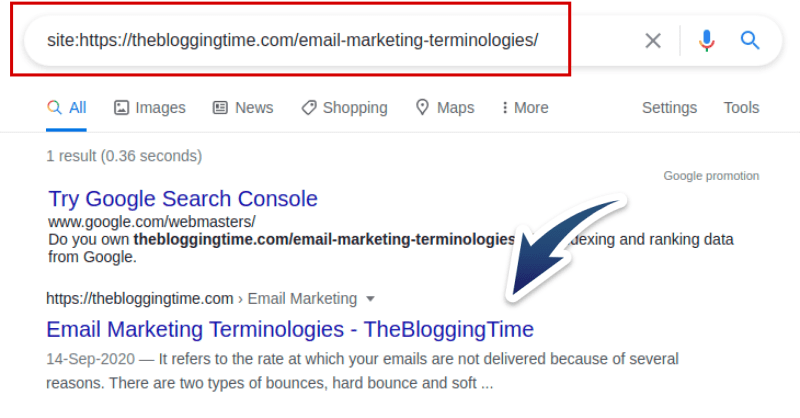Did you just wrote a new blog post and it’s not indexing in search engines like Google?
Don’t worry.
In this blog post, I’ll suggest the best ways to index new blog posts quickly in search engine results.
Most of the time whenever you write any blog post, indexing of URL is an automated process but due to certain factors, it may get missed.
It’s not about Google, you need to follow few steps to index your blog post in any search engine.
Also, before starting you need to remember that it’s not 100% guaranteed that the below steps will work because most of the time indexing a blog post depends on the crawl rate also (which you can’t change) for any search engine.
But Yes, if you’re lacking somewhere else then I’ll definitely get you out of trouble.
First, let’s find out how to know if your post/page is indexed or not?
Just enter you blog post URL and add prefix to it i.e “site:“

Now if you’re URL doesn’t appear on Google, that means it is not indexed. Now the goal is “to let a search engine know that a new URL is published on the Web”
Let’s see how to do that.
1: Verify Your Site In Webmaster Tool
This is the point, where whole automated indexing starts.
If you own any website, you just need to add that into the webmaster tool of search engines.
Such as,
For Google, you need to add your site to Google Search Console.
For Bing, you need to add your site to Bing Webmaster Tool.
After adding your website to the webmaster tools, your sitemap will be read automatically after a certain period of time and your new blog post will get indexed in search results.
It’s like telling search engines that “Hey! this is my website and index it every time I update something“
Sitemap plays important role in crawling because they contain a list of web pages of a website.
For WordPress users, I’ve written a dedicated blog post on how to add a sitemap to WordPress.
After adding your website to the webmaster tools, you increase your chance of getting index fast by almost 90%
But what if my posts are not getting indexing after that?
Yes, it can happen. Let’s discuss a few more tactics.
2. Submit the Sitemap Of Your Blog
After adding your site to the webmaster tool, submitting a sitemap is the most crucial part else nothing will work. I also discussed in the previous method the importance of a sitemap.
Every time you add a new post/page to your site it gets updated in the sitemap as well and the next time search engines crawl your website they’ll find a new link and add it to their index.
First of all, you’ll need to grab the sitemap link. It looks like “https://xyz.com/sitemap_index.xml”

Then add it to the webmaster tool,
For Google, follow this guide to add a sitemap to Google Webmaster.
For Bing, follow this guide to add a sitemap to Bing Webmaster.
That’s it. Now next time crawlers will l come to your site they’ll get enough data to index.
3. Interlink your content
This is my favorite.
Interlinking your content has tons of benefits, and if you’ve written a decent amount of posts, then you’ll have enough posts to interlink the content.
The most common pattern of crawling for search engines is crawling from page to page. Once a crawler enters any HTML page, it will crawl to all interlinked pages (dofollow links only)
Understand the difference between Dofollow and Nofollow Links.
What you’ve to do? Find popular and related web pages of your blog and insert a link to your new blog post.
This way next time the crawler hits your popular web page, the higher the chance of indexing your new post.
4. Share content on Social Media
Search engine crawlers are all over the internet. We just need to make them notice that we’ve published a new blog post.
Facebook, Quora, and Twitter are powerful networks that Google crawls regularly and this is the best way to get your link noticed.

Go to your social media handles. Share your post across the platform and you’ll definitely get results.
5. Comment on Popular Blogs
If your blog is new then this technique will help you in many different ways.
Commenting on blogs is also a grey-hat SEO strategy and it will gain you some attraction in terms of SEO and traffic as well.
Find some blogs in your niche with high traffic and high domain authority.
Go to the comments section and write a meaningful comment and post it there.

Remember, to use your name as the anchor text (because of authenticity). Also, it will add a no-follow link to your website.
6: Manually Ask For Indexing
Uhh, If nothing works, ask search engines to index your post.
Asking search engines manually to index your post sometimes works because you are forcefully requesting to index the URL.

But if all the above steps are not working for you then you must need to look out for reasons why your blog posts are not indexing.
Hope this helps.
Conclusion: Index New Blog Posts
As I said earlier, indexing is an automated process and the above steps are just addon that you can try to index new blog posts quickly.
In the end, there are some fundamentals that you need to follow to build a health indexing ratio such as the structure of your post, internal links, external links, quality content, incoming links, and many more.
I hope the above steps will help you out to index your blog post faster in Google, Bing, or any other search engine.
Let me know your thoughts in the comment section below and don’t forget to share this article.

Wow amazing article dude…
Thank you very much for the post that helps my blog to index very quickly.
You’re welcome